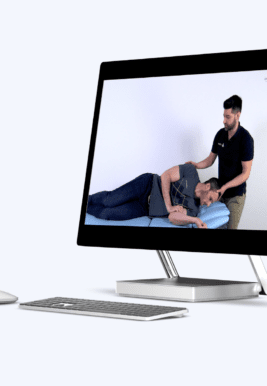Learn
Semont Maneuver | Posterior BPPV Treatment | Vertigo Treatment
Benign paroxysmal positional vertigo, abbreviated as BPPV is the most common inner ear problem and cause of vertigo, or false sense of spinning.. Common causes are head trauma or ear infections, although most cases appear to be idiopathic.BPPV can be caused by debris in the semicircular canal of the ear, which continues to move after the head has stopped moving. This causes ongoing movement that conflicts with other sensory information.
The semicircular canals are filled with a fluid called endolymph. The main sense organ in each canal is called the crista, which is stimulated by movement of the cupula. Head rotation causes relative movement of the endolymph in the semicircular canal, which bends the cupula and the embedded hairs of the hair cells and causes stimulation of the relevant vestibular nerve.The cause of BPPV is believed to be canalithiasis, affecting the posterior semicircular canal in 85 to 95% of all cases. In canalithiasis, free-floating debris in the semicircular canal is hypothesized to act like a plunger, causing continuing movement of the endolymph even after head movement has ceased. This causes movement of the cupula and bending of the hairs of the hair cells, and provokes vertigo.
Around 20% of BPPV cases are said to resolve within 4 weeks and up to 50% up to 3 months without treatment, but recurrence is reported between 10-18% after 1 year.The Semont liberatory maneuver involves a series of movements of the head and body in order to move the debris out of the posterior semicircular canal.
In a Cochrane review from 2014, Hilton et al. found that the Semont maneuver was more effective than sham maneuvers or control. There was no difference when Semont was compared to with the Epley maneuver that you can watch by a click in the top right corner. The chance of success in this review was described to be as high as 85%.Be aware that the Epley maneuver can lead to nausea which was reported in 17-32% of patients. So make sure you have a bucket at hand, in case your patient might need it. The patient should be counseled that his symptoms of vertigo will be reproduced and that he might feel nausea. On top of that, make sure that your patient is able to tolerate neck movement.
To perform the Semont maneuver have your patient sit in the middle of the treatment bench with the head turned away from the affected right side. Then quickly bring the patient into side-lying position toward the affected side with the head turned up. A nystagmus will occur shortly after arriving at the side-lying position and the patient will probably experience vertigo. Keep the patient in this position until at least 20 seconds after all nystagmus has ceased. Some even recommend up to 1-2 minutes.
Then quickly move the patient back up with the same head position and through the sitting position so that he is in the opposite-lying position with the head facing down. Again, keep the patient in this position for about 30 seconds. Again, some other authors report holding this position for even 2 to 10 minutes.
At last, slowly bring the patient back up into sitting position.
A meta-analysis from Devaiah et al. from the year 2010 showed that post-maneuver restrictions are not necessary as they have not shown any significant benefit compared to no restrictions.
The literature demonstrated beneficial effects of multiple treatment sessions for patients with persistent nystagmus following the initial maneuver. Be aware, that canal conversion from the posterior into the lateral semicircular canal occurs in 6-7% of those treated with canalith repositioning procedures. Therefore, it is important to recognize the canal variant of BBPV as well.
Another effective maneuver for pBPPV is the Epley maneuver. In case you suspect lateral BPPV, you will have to perform the BBQ roll maneuver.
LEARN TO TREAT THE MOST COMMON CAUSE OF VERTIGO IN THIS FREE MINI-VIDEO-SERIES

References:
References
Like what you’re learning?
BUY THE FULL PHYSIOTUTORS ASSESSMENT BOOK
- 600+ Pages e-Book
- Interactive Content (Direct Video Demonstration, PubMed articles)
- Statistical Values for all Special Tests from the latest research
- Available in 🇬🇧 🇩🇪 🇫🇷 🇪🇸 🇮🇹 🇵🇹 🇹🇷
- And much more!








